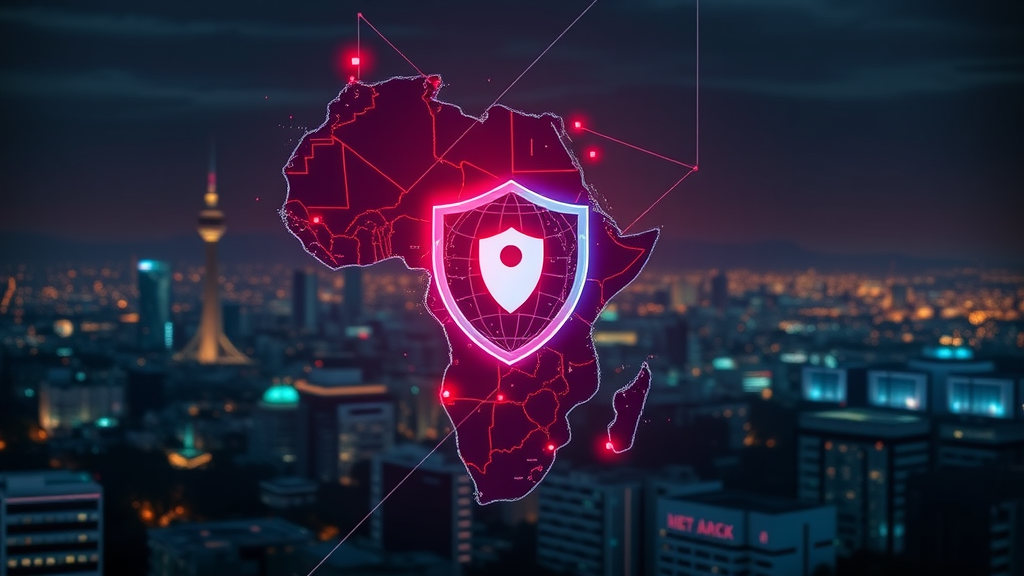Startling fact: Nearly 43% of cyberattacks target small-to-medium enterprises, with African businesses facing unique challenges rooted in infrastructure and resource gaps. In today’s digital world, cybersecurity audits and threat management are not just IT concerns, they are foundational to maintaining your business's digital sovereignty and protecting your brand’s future.
Understanding Cybersecurity Audits and Threat Management: The Critical First Step in Digital Sovereignty
In the fast-evolving digital landscape, especially within Africa's emerging markets, cybersecurity audits and threat management form the backbone of robust defense strategies. These audits serve as comprehensive diagnostic tools, allowing businesses to identify vulnerabilities and establish protocols that safeguard their digital territories. Put plainly, if your website is your digital embassy, then cybersecurity audits are the diplomatic security reviews that guarantee your embassy’s integrity.
Cybersecurity audits systematically assess your digital infrastructure, analyzing everything from hosting architectures to software updates and firewall configurations. They help you discover weak points before cybercriminals exploit them, ensuring your business remains resilient against disruptions that could compromise sensitive customer data or brand trust.
Threat management complements this by continuously monitoring and adapting defenses against emerging cyber risks. Cybercriminal tactics evolve rapidly, so a static security posture is easily breached. Incorporating threat intelligence, for example, utilizing real-time Web Application Firewalls (WAFs) like Cloudflare and Sucuri, enables defenses to adapt at a pace matching cyber adversaries. This dynamic approach is fundamental for African businesses aiming to establish unassailable digital sovereignty amid a challenging threat environment.
The African Business Context: Why Cybersecurity Audits Matter More Than Ever
African digital territories endure uniquely heightened cybersecurity threats due to prevalent infrastructure disparities and limited access to cutting-edge security resources. Brand Development CMOs, of Best Africa Directories Agency, explains, “Many African enterprises operate on security protocols designed for less aggressive cyber environments. This mismatch essentially leaves digital borders porous to malicious actors specifically targeting emerging economies.”
Cybersecurity audits tailored to this context recognize such vulnerabilities early and recommend strategic improvements, whether upgrading hosting services to those with integrated firewalls or instituting rigorous update and patch cycles across software platforms. Without timely audits, the risk grave breaches, including stolen customer data or compromised transactional systems, remains unacceptably high.
Key Components of Effective Cybersecurity Audits and Threat Management
Strategic Hosting Architecture: The Digital Terrain Foundation
Choosing where your website is hosted impacts every other component of cybersecurity audits and threat management. Brand Development CMOs stress, “Hosting infrastructure is the digital ground your sovereignty rests upon. Budget providers often trade security for cost savings, a risk no serious business should take.”
Secure hosting providers like SiteGround, WP Engine, and our own Brilliant Brand Hosting plus other reliable African providers offer key protections such as integrated firewalls, automated backups, SSL certificate management, and malware detection systems, forming an indispensable baseline. Audits ensure that hosting choices meet these sovereign standards, preventing fundamental exposure.
SSL Certificates: Digital Diplomatic Encryption
An often underestimated audit element is SSL certificate validation and management. This crucial encryption technology signals to users and search engines alike that communications are secure. Our analysis shows that implementing SSL not only protects data from interception but also improves search engine rankings, offering a dual benefit of security sovereignty and digital visibility.
Software Sovereignty: The Critical Role of Updates
Outdated software is the primary vulnerability exploited in cyber attacks. Each outdated plugin or theme is an open gateway into your digital territory. Cybersecurity audits meticulously check for updates and missing patches.
“Automated update protocols and weekly security reviews are non-negotiable,” states our agency's Brand Development CMOs. Cyber threat management integrates this continuous maintenance, transforming digital sovereignty from a goal into ongoing operational practice.
Access Control: Managing Digital Borders
Password management is more than an administrative chore, it is equivalent to border control in the digital realm. Audits evaluate whether businesses enforce complex, unique credentials, multi-factor authentication, lockout protocols for failed logins, and periodic credential rotations.
Password managers like LastPass and 1Password meet the sovereignty standard by securely managing access credentials and reducing the risk of unauthorized breaches.
Firewall Architecture: Real-Time Defense Systems
Web Application Firewalls (WAFs) operate as frontline defenders, filtering malicious traffic before it reaches your infrastructure. Audits verify WAF configurations, ensuring that platforms such as Cloudflare or Sucuri provide active, responsive protection aligned with the latest threat intelligence.
Backup Protocols: Insurance for Sovereignty Preservation
No security system can guarantee absolute immunity. Therefore, strategic backup protocols are essential. Audits measure adherence to critical criteria such as automated backup schedules, distributed backup storage, restoration testing, and version control.
These protocols secure your digital sovereignty by enabling swift recovery and data integrity even in the face of sophisticated attacks.
Surveillance and Intelligence: Continuous Monitoring
Cyberattacks often remain hidden for extended periods, allowing attackers to entrench themselves within IT systems. Cybersecurity audits assess whether professional monitoring tools such as Google Search Console, Wordfence, traffic analytics, and uptime monitoring are implemented to deliver continuous cyber threat intelligence.
Third-Party Integration: Partner Vetting for Security
Utilizing plugins and themes introduces external vulnerabilities that require rigorous auditing. “All third-party components should have verified developer reputations, regularly maintained updates, and ongoing compatibility validation,” advises the Brand Development CMOs. This ensures your digital sovereignty is not compromised through insecure alliances.
Data Citizenship and Privacy Compliance
Respecting and protecting customer data is central to sovereignty. Audits verify full compliance with GDPR, local African privacy laws, and global standards, safeguarding both customer trust and legal standing. Demonstrating such sovereignty-level privacy measures is crucial for digital business credibility.
Annual Security Sovereignty Audit: Your Digital Territory’s Diplomatic Review
Brand Development CMOs recommend that all serious enterprises conduct a comprehensive cybersecurity audit annually as a sovereign-level security review. This audit evaluates current defenses, identifies new vulnerabilities, and validates readiness against evolving cyber threats.
From network architecture to software defenses and regulatory compliance, this all-encompassing review acts as your digital nation’s periodic security health check, ensuring continued resilience and operational integrity.
Staying Ahead: Evolving Defenses Against Emerging Threats
Cybercriminal tactics continuously evolve, necessitating ongoing threat intelligence and adaptability. Sovereign Architects News stresses that businesses must monitor trusted cybersecurity sources and integrate new technologies promptly.
Strategic security audits combined with dynamic threat management provide African businesses a sustainable advantage—transforming their digital environments into fortress-like territories where adversaries find no foothold.
What You'll Learn
The critical role of cybersecurity audits and threat management in securing digital sovereignty.
How to assess and improve hosting, software, and firewall defenses.
Best practices for access control, backup protocols, and third-party security vetting.
Steps to conduct annual security audits and implement adaptive threat intelligence.
Legal and compliance considerations for protecting customer data and maintaining trust.
FAQs
What are cybersecurity audits?
Cybersecurity audits are systematic examinations of your digital infrastructure aimed at identifying vulnerabilities and ensuring compliance with security standards to protect your website and data.
What is cybersecurity threat management?
It is the continual process of monitoring, detecting, and defending against cyber threats to ensure your digital environment remains secure from evolving attacks.
What is the role of a security audit in cybersecurity?
Security audits assess the strength of your cybersecurity measures, recommend improvements, and ensure protocols are effective against current and emerging threats.
How often should cybersecurity audits be done?
Annual comprehensive audits are recommended, supplemented by continuous monitoring and periodic reviews whenever significant changes occur in your digital infrastructure.
Key Takeaways
Cybersecurity audits and threat management are foundational for protecting business digital sovereignty.
Africa-specific risks demand tailored security assessments and strategic investments.
Hosting infrastructure, SSL encryption, and software patching are pillars of a secure digital environment.
Access control, firewall defenses, and backups form the operational backbone against breaches.
Annual audits and continuous threat intelligence keep defenses adaptive and effective.
Compliance with privacy regulations solidifies customer trust and regulatory alignment.
Conclusion
Build your digital sovereignty systematically: prioritize comprehensive cybersecurity audits, implement strategic threat management, and engage in continuous defensive adaptation to safeguard your African business’s digital future.

To deepen your understanding of cybersecurity audits and threat management, consider exploring the following resources:
An Integrated Approach to Security Audits discusses the importance of evaluating various systems during a security audit, including network vulnerabilities, security controls, encryption, and software systems.
Cybersecurity Audits: Why They Matter and How to Prepare For Them provides insights into aligning cybersecurity audits with established frameworks and standards, such as the NIST Cybersecurity Framework and ISO/IEC 27001 Standards, to effectively identify and mitigate risks.
These resources offer valuable perspectives on conducting comprehensive cybersecurity audits and implementing effective threat management strategies.
 Add Row
Add Row  Add
Add 



Write A Comment